NSW Nurses and Midwives strike: personal horror stories from hospitals
Nurses have revealed personal horror stories inside NSW hospitals including assaults requiring spinal surgeries, knives to their throats, and have blood thrown on them.
Local
Don't miss out on the headlines from Local. Followed categories will be added to My News.
Nurses striking across the state have revealed devastating stories of horror working conditions in an effort to improve staff to patient ratios in under-sieged hospital wards.
An emergency nurse, who addressed tens of thousands of her colleagues from across the state said she had suffered from a range of attacks in the workplace — due to understaffing.
“I have been attacked,” she told heartbroken colleagues on Tuesday morning. “I have had blood thrown in my face intentionally.
“We’ve had staff members punched in the face — we’ve had a knife put to our throat.
“I asked you what is a nurse’s life worth?”
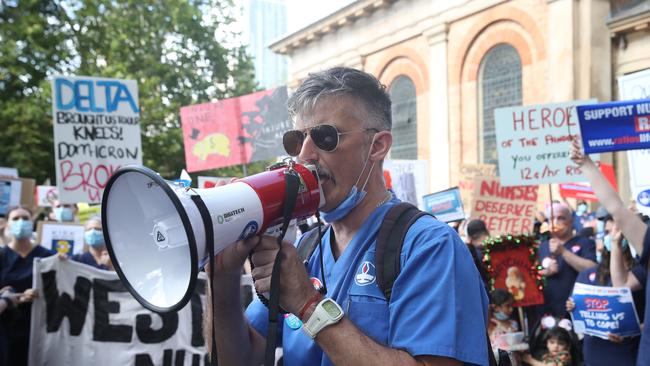
Meanwhile a Mental Health specialist nurse said she has horrifically assaulted on the job.
“It resulted in me needing two spinal surgeries, one of which included a piece of titanium being inserted in my neck so that it stayed stable,” she said.
“I’m not the only one that has been injured in our workforce, and we know that ratios can assist to address this.”
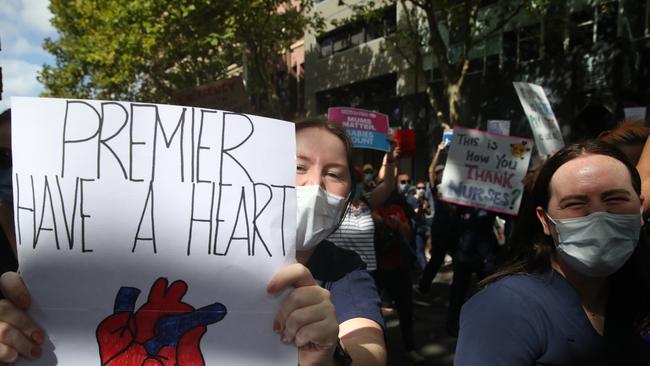
The mental health nurse from Wollongong said nurses and midwives “have a professional obligation to provide safe and quality care”.
“Therefore, it is our professional obligation to pursue industrial action,” she said.
“To campaign for mandated ratios, wage justice and a sustainable healthcare system.”
Tens of thousands of frustrated nurses and midwives shut down Macquarie St, in the heart of the Sydney CBD, in an effort to secure better staff to patient ratios from NSW health.
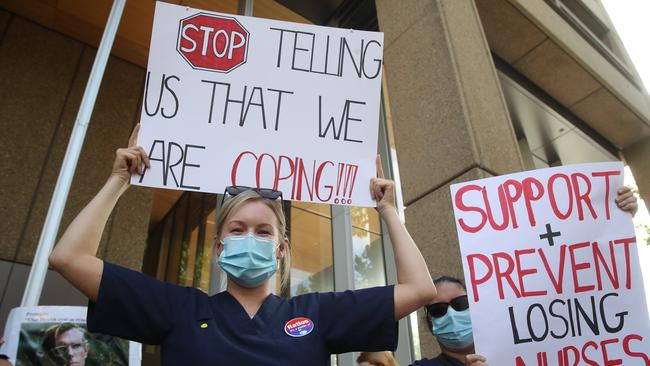
The CBD rally is one of 20 different demonstrations planned by the NSW Nurses and Midwives’ Association for February 15, with nurses across the state pledging to continue to strike unless the NSW Government come to the table.
Trevor Lambert, of Blacktown, transferred his father Allister after an appointment at Westmead Hospital, where he had treatment for eye shingles.
“The staff were very under the pump, very courteous,’’ Trevor said. “We were there three-and-a-half hours today. It’s not the staff’s fault. Police, fireys and ambos are on the frontline - they deserve more money.’’
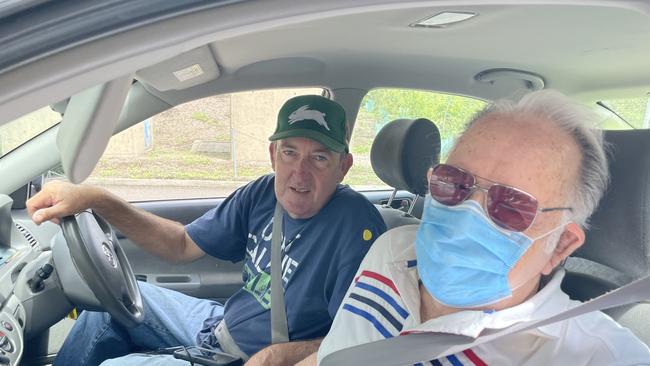
James and Stephanie Carmen, of Glenorie, supported the strike. Mrs Carmen gave birth to daughter Kasey on February 10 and was discharged on Monday but returned for a visit on Tuesday.
“They definitely deserve to have more budget so they can hire more so they’re not overworked,’’ she said.
Mr Carmen endorsed the strike action: “I think they do an amazing job”.
‘HOSPITALS ARE OVERWHELMED’: WESTMEAD STAFF
West Pennant Hills’ Bill Carpenter, 83, who just finished visiting Westmead Hospital’s cancer clinic for a review, backed the nurses’ strike.
“They are underpaid and overworked,” he said. “He (Premier Dominic Perrottet) doesn’t know. He’s sitting there on Macquarie St like all politicians, whoever they are.”
Carer Susie, who often drops patients off at Royal North Shore Hospital, also supported the strike but believes the message could have been conveyed differently.
“I do wonder if there might be a better way to do it that didn’t impact on patients and waiting times,” she said.
She said administrative staff could have refused to collect fees in an effort to drop revenue.
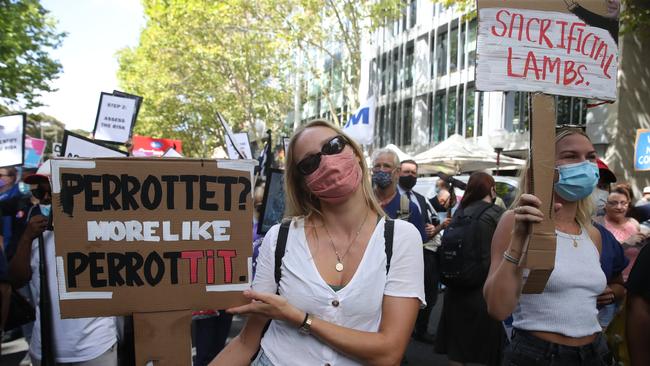
“The hospitals are just overwhelmed and they’re struggling and when a crumbling system’s already breaking and then you have a pandemic I don’t know how you can expect to survive,’’
A doctor of four years, who did not wish to give her surname, said .
“All health care staff are exhausted and hopefully they give it some attention and they start staffing hospitals adequately.’’
A graduate nurse said: “We struggle a lot during the pandemic, we’re not being heard, we were not getting our breaks.’’
Johnny Hocherg, who is a podiatrist in the outpatient clinic, supported the strike despite working in a separate department to other nurse feeling the brunt.
“Public health traditionally is understaffed,“ he said.
At the Coffee Box cafe outside the hospital, business is quiet without doctors are nurses who make up between 50 and 60 per cent of the cafe’s customers.
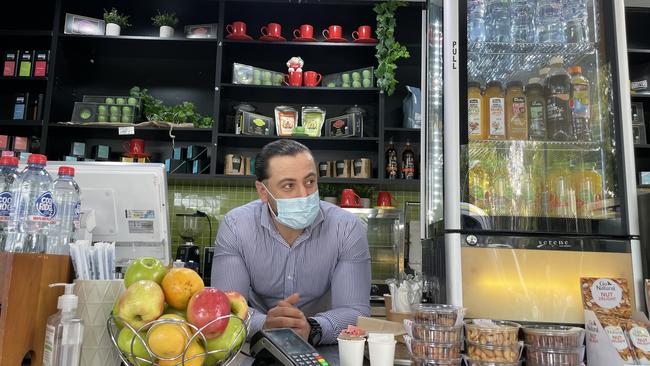
“We have been very quiet,“ manager Omar Chechen said. “It’s dropped about 30, 40 per cent because I haven’t seen any traffic. Usually I see people up the road getting their lunch or coffee and there’s no traffic of nurses and doctors.”
Meanwhile, Hayley, who works in day surgery at the Children’s Hospital at Westmead, is part of the skeleton staff who will work while her colleagues strike.
“I think it’s a good idea,” she said before beginning an eight-hour shift.
“I really feel for the nurses who have been in emergency and ICU.
“They don’t have any set patient ratios so they can have any amount of patients which is unsafe. I could have went on strike today if I wanted to but some staff had to stay. It becomes a moral thing.”
The 23-year-old, who declined to give her surname, has been a nurse for three years.
UNION HITS OUT
NSWNMA General Secretary, Brett Holmes, said members had reached the end of their goodwill and were desperate for the government to listen to their pleas for nurse-to-patient ratios.
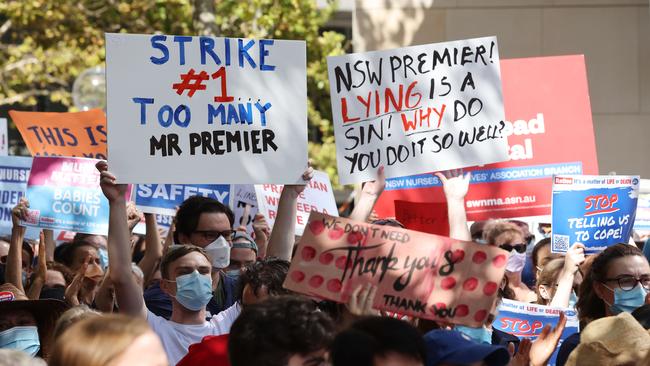
“Our members are calling for commitment from the Premier that there will be enough nurses and midwives on every shift, he said.
“Nurses and midwives have signalled how fed up they are with the NSW government for ignoring the need for nurse-to-patient ratios, similar to those already working successfully in Queensland and Victoria.
“The staffing crisis in health won’t simply go away on its own. COVID-19 has only exacerbated the failings of our health system. What we’re asking for is not unreasonable. Nurse-to-patient ratios do save lives and result in better patient outcomes.”
‘MORE STRIKES WILL COME’: SOUTH COAST NURSES
Nurses at Shoalhaven District Hospital in Nowra warn of more strikes if demands aren’t met.
Nurses from the busy south coast hospital were joined by staff from across the region in Tuesday’s groundbreaking industrial action — with nurses coming from as far afield as Batemans Bay, Moruya, and Milton.
Diane Smith travelled from the Milton Ulladulla Hospital to participate in the protest on the hospital lawn.

She said assurances from the NSW Government that the region’s hospitals were coping were falling on deaf ears.
“We’re not coping,” she said. “The patients can’t get out of bed, but you can’t prevent falls from happening because there’s not enough nurses.
“They’re at risk: they could break their hip or hit their head.”
Ms Smith works in the medical, surgical, and subacute geraitric wards at Milton Hospital.
For her, the introduction of nursing staff ratios would mean an increase to patient safety.
“We can’t get nurses, so no one’s looking after confused patients,” she said. “And, that’s really sad for families. But, what else can we do?”
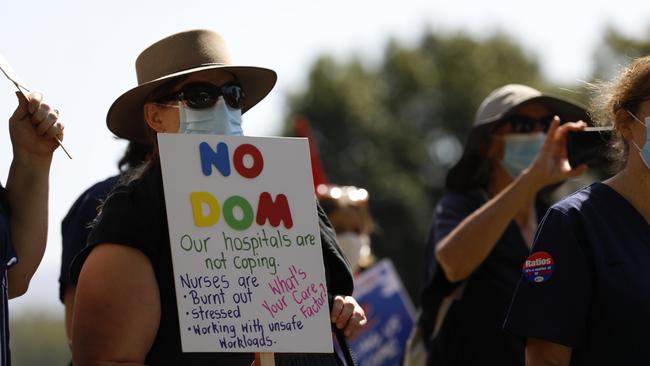
Teresa Smith also travelled from Milton hospital to Nowra on Tuesday.
She said nurses would sooner implement ratios then take the 2.5 per cent pay rise suggested by the NSW Nurses and Midwives Association.
She believes pay rises promised to them more than a year ago had not been delivered upon.
“When Covid struck, they said they weren’t going to give us our pay rise,” she said.
“At one stage they offered us $1000, but that would go nowhere.
“The government got a pay rise, but they say we are doing okay?
“Fares go up, groceries go up.”
NSWNMA Shoalhaven hospital branch president Michael Clark said the numbers of nurses striking were heartening, but warned there was still a long road ahead.
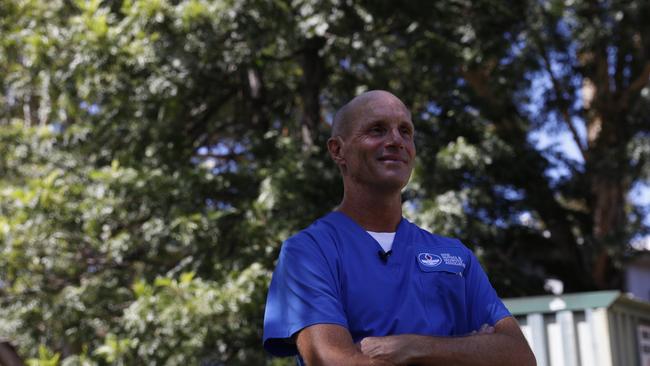
“We had trouble with like-for-like replacements (before Covid); we had trouble with specialists; we had trouble with skill mixes; and, we had trouble with filling gaps in the roster,” he said. “Legally mandated ratios would go a long way to addressing those issues.”
Mr Clarke said some nurses were being forced into completing overtime out of a sense of duty for their coworkers, while others were leaving the industry altogether out of burnout.
“Some of the junior nurses that came into the system have just found it just too hard going and have had to leave well before their time,” he said. “The senior nurses have said: ‘I’ve had enough’.
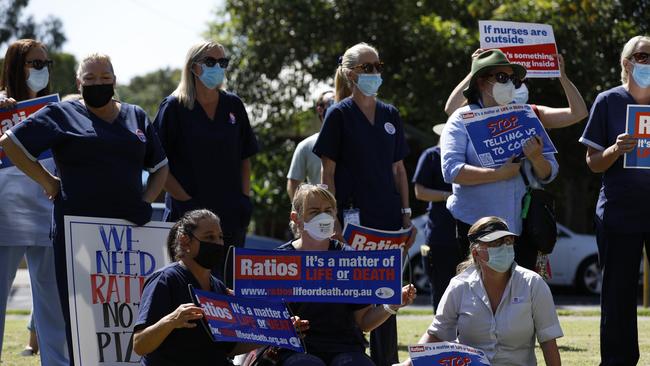
“There are other options out there, and nurses and midwives are investigating those options.”
The current crisis doesn’t just affect nurses, advocates said.
Tuesday’s strike was joined by members from the paramedics unions, teachers unions, as well as local midwives.
Carol Bailey has worked as a midwife in the Shoalhaven District Hospital maternity ward for 36 years, and said ratios would profoundly impact their quality of care.
“Our babies aren’t counted in patient numbers,” Ms Bailey said.
“Ratios would mean better care for our babies and for our mothers, and for us in general.”
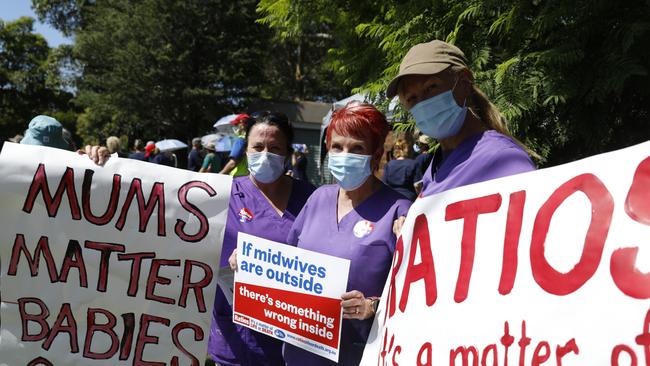
Fellow Shoalhaven midwife Jenny Craig said she had never felt so disrespected as she had in the most recent round of debate between the State Government and nurses unions.
“We’re undervalued, but not by the community,” she said. “A midwife can actually have to look after 20 patients on her own: 10 mothers and 10 babies.
“How can we give adequate care?”
Meanwhile, Shoalhaven midwife Linda Smith added that for many staff, the current system had left them burnt out.
“We’re exhausted, we’re burnout, and we’re losing staff, but there’s no strategy for replacing those staff,” she said. “The State Government needs to listen.
“Everybody’s struggling.”
100 HOUR WAIT FOR PATIENTS
President of the NSWNMA Port Macquarie Base Hospital branch, Mark Brennan, headed the march through Port Macquarie on Tuesday.
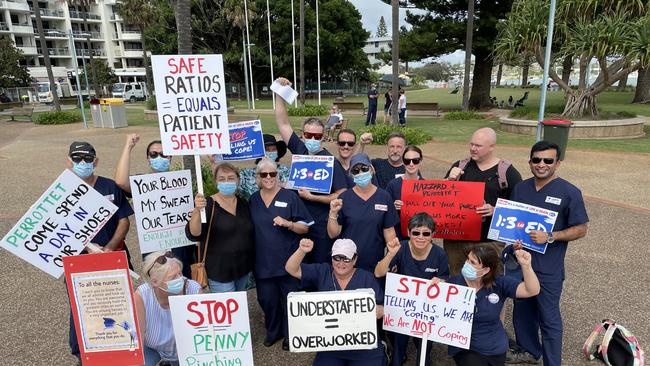
Mr Brennan said a patient waited in Port Macquarie hospital for over 100 hours just yesterday.
“Every single department is short – we are not coping,” he said. “The government knew this strain on the industry was coming, and they did nothing about it – we need to vote them out.
“Today’s strike is just the beginning, we will keep applying pressure until something is done.”
Local nurse and strike participant, Kim Wiegold, explained why these ratios are so alarming.
“So it’s common for nurses to be caring for multiple patients, with a variety of different issues, which just isn’t safe,” she said.

“It’s the same for midwives – newborn babies aren’t counted in the ratio so some midwives can end up managing, for example, four mothers and up to five babies at once.”
Ms Wiegold said today’s strike is the result of years of this kind of injustice.
“The changes we’re advocating for today are not new, we’re been fighting for them for years,” she said. “To say that this is due to Covid is just misleading.
“We were already in a dire position before the pandemic started.”
‘UNDERSTAFFING BRINGING US UNDONE’: CENTRAL COAST NURSES
Central Coast surgical nurse and NSWNMA Gosford Branch President and counsellor Meg Pendrick joined the busloads of Central Coast nurses at the protest.
“It was full on, when you were on the ground it looked like thousands and thousands of people,” she said.
“We needed to do this strike action, we are just not being listened to. We are sick and tired of being told we are coping... we are not coping.”
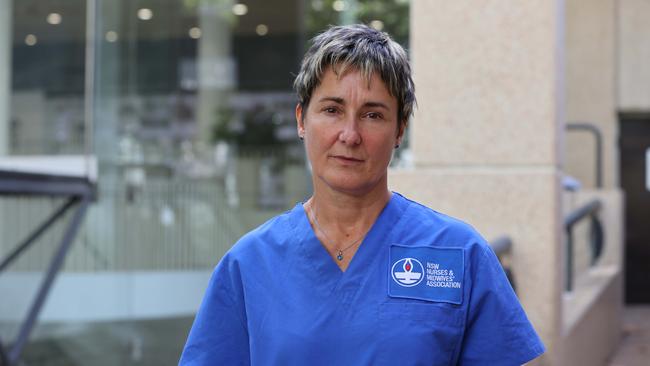
Ms Pendrick, who has worked at Gosford Hospital for 14 years, said it’s the same story across the Central Coast - hospitals are short staffed, nurses are fatigued with may resigning and wages need to be increased.
“The lack of staff is what is bringing us undone,” she said. “There’s always a budgetary push to minimise staff on the floor. We are asked to do the job of two to three to four people. I work on shifts where we should have nine nurses and we only have five.
“That’s shift after shift, month after month and now into years. You keep thinking, ‘when will it be the final nail in the coffin for that nurse’. You can see they are burning out, even the younger ones.”
Ms Pendrick said the situation was “dire” across the growing region.
“You can’t do this job safely with less nurses,” she said. “In this job, it can be a matter of noticing a decline in a patient.

“Some shifts I don’t have time to engage in conversations with our patients, I am just running from one task to the next. I feel very scared for our community.
“The area is growing and our patients are more and more acute. We have a large component of elderly people and a large component of chronic diseases.”
She said the situation could have been fixed years ago when nurses were pushing for improved ratios.
“If you run us on a bare minimum and a pandemic hits... it annihilates us. Everyone is running on nothing. It’s pure exhaustion. Something has to change... they need to listen.”



